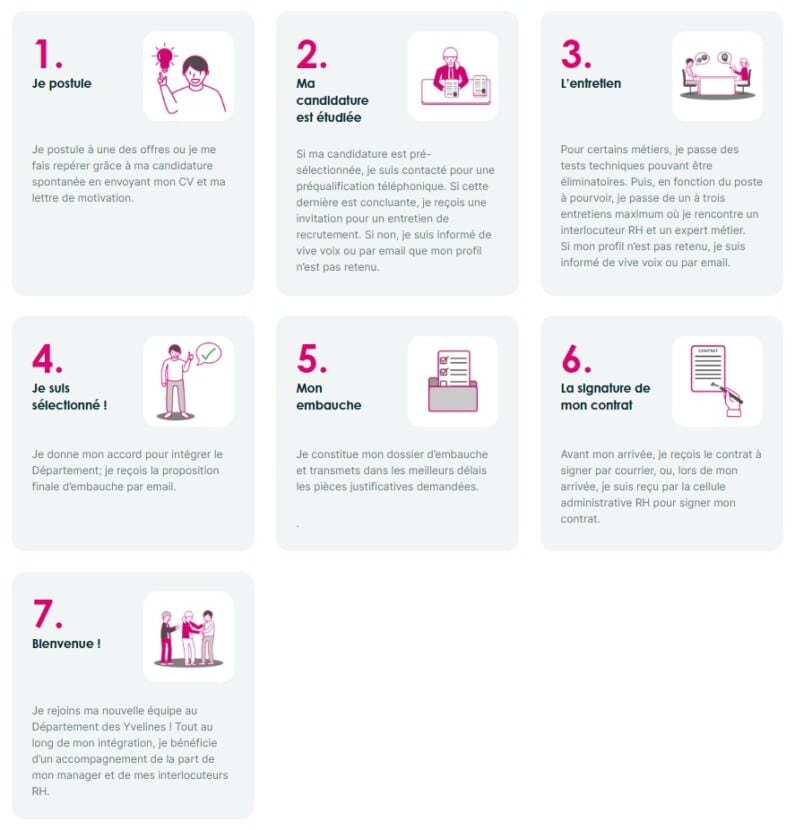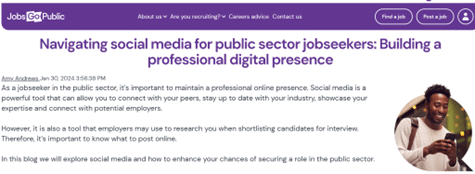Although well established in the private sector, employer branding is not - not yet, not sufficiently or not everywhere - part of the reflexes of public sector recruiters and decision-makers. But with recruitment becoming increasingly difficult, the practice is set to expand. So how do we go about it? Michelle Goldberger, trainer in employer branding and social networks, explains.

Despite its security and benefits, the civil service is no longer as attractive as it used to be. As the DGAFP (Direction générale de l'administration et de la fonction publique) has noted, there are fewer new recruits than vacancies.
For example, in 2021, 39,900 positions were open to external recruitment of civil servants. However, only 36,700 civil servants were recruited, 800 fewer than in 2020. Finally, just over 3,100 positions were not filled in 2021, i.e. 8 % of the positions offered (DGAPF, Stats Rapides, May 2023). This is a global phenomenon that also affects local authorities. For example, 67 % of local authorities are experiencing recurring recruitment problems, according to the 14e Randstad HR barometer. And the decline in the number of applicants is not confined to local authority jobs! More generally, the average number of applicants for a post has fallen from 16 in 1997 to 6 in 2022 (annual report on the state of the civil service). To an extreme situation in the hospital civil service, where 99 % of employers are finding it difficult to recruit.
Several reasons are often put forward to explain this phenomenon:
- lack of attractiveness of certain professions
- complicated" mobility
- low wages
- too "classic
- bad atmosphere
- complex recruitment processes...
While some of them are very real, others fall into the category of "old preconceptions". So how do you get to grips with them? How can public-sector recruiters reverse the trend? Employer branding is one of the tools at their disposal.
Employer branding: a practice born of the inversion of the recruiter/candidate balance of power
The relationship between recruiters and candidates has changed, especially in the private sector. Today, candidates know that they have a choice! They have a better understanding of their own worth, they know how to 'sell' themselves and they don't let themselves be taken advantage of. If the employer doesn't keep his promises, or if there's something else they don't like, candidates tend to flee. This is forcing companies to work on their attractiveness: social networks, applications, recruitment and onboarding processes are all being put at the service of their employer brand. They have gone from being buyers to sellers!
Recruiters/HR are no longer in a recruitment world where they hold the reins!
Today, the #CandidateCentricity should be the norm in recruitment. In other words, a world where candidates are treated like customers and put at the centre of all decisions and activities by recruiters/HR!
A reality conveyed by social networks, the press and other media. And it's also having an impact on relations between applicants and public sector recruiters. Faced with a shortage of applicants and fierce competition from private-sector recruiters, public-sector employers no longer have a choice. They have to change their strategy to attract candidates. And that includes adopting the techniques of the private sector. After all, why shouldn't administrations, local authorities and other public bodies 'sell' themselves through their job offers and employer brand?
First step: understanding the employer brand
Definition
Employer branding is a continuous process in which all the tangible and intangible elements that make up the image and reputation of the administration, local authority, etc. are organised and communicated at all stages of recruitment.
For example:
For an administration, the employer brand is made up of 4 elements.
- What administration really is
- What the authorities say about themselves
- What employees say about her
- What the public says about her
In other words, employer branding is a cocktail of :
- human resources
- marketing
- communication
- real values of the public entity
- employees themselves
Employer branding for recruitment: putting it into practice
So what are the best techniques for putting all these elements to music?
1/ Communicate transparently
It is good practice to explain the recruitment process clearly in advance, indicating the stages involved. So is repeating this information on the phone, face-to-face, etc., in other words during every interaction with candidates. Transparency contributes to a feeling of psychological security.
Example: in a job advert published on the LinkedIn page of the Ministry of the Economy, Finance and Industrial and Digital Sovereignty

Another example: a job advert published on the Yvelines department's recruitment website (image 1) leads to a page dedicated to the candidate's career path, broken down into 7 stages (image 2).
Image 1

Image 2

2/ Being in the "real world
Explain in simple words and show in concrete terms what candidates will be working on and how their contributions can help to change things internally. This can be done through job advertisements in particular, or through other communications (publications on social networks, for example). The aim? To enable candidates to project themselves, imagine themselves working for the job in question and align themselves with the same values.
Three examples:
1/ In a job offer on the City of Nice website

2/ On the City of Lyon's LinkedIn page

3/ A video presentation of a job in the City of Paris
The little-known job of gravedigger is presented as "The job where you are the hero".






3/ Guiding candidates
The aim is to teach candidates how public sector recruitment works. For example: giving tips on how to improve their applications, build an online presence in line with the public sector, prepare for interviews, etc.
Example 1: on an American website promoting jobs in the public sector

"How to build a professional digital presence for your job search in the public sector".
Example 2: on the Instagram account of @objectifpatrimoine

4/ Making an impression through impactful communication
Communication is a crucial part of employer branding! Properly designed, it will modernise your image as a public employer. In particular, to reach out to new generations: millennials (born between 1980 and 2000) and Generation Z (born between the late 1990s and early 2010s).
Be creative, motivating and memorable
Which communication channels? In practical terms, this involves writing communication content for social networks, websites, job search sites, the media, etc.
What content? Slogans, hashtags, descriptions, website names...
What tone? Be punchy. It has to be easy to remember!
Here are a few examples:
Slogan and website name, seen on: https://www.fonction-publique.gouv.fr/

Slogan on the Yvelines department recruitment website: https://recrutement.yvelines.fr/

Hashtag in a job advert on LinkedIn: #lhumainattheheartofneeds

Film of the campaign "These jobs that take us forward" on the DGAFP YouTube channel
5/ Involve all stakeholders to multiply the effects
Invite employees, Internet users, partners, etc. to take part in the recruitment process and help spread the employer brand! Include them in the process and get the community going. The result? A positive feeling of belonging.
Example: on the LinkedIn page of Emploi-collectivites.fr

6/ Showing a sense of humour
Humour makes a public authority's employer brand more human and accessible to candidates. It also suggests that the atmosphere is not gloomy, unlike in a priori that certain candidates might have on the public sector.
Case in point: French customs. Their K9 has its own account on Instagram!
"K9" comes from the English word "canine", which simply means "dog".
So say "key" [keɪ] + "nine" [naɪn].

What does customs do? As soon as goods cross borders and are in circulation, the State is obliged to "identify, tax, control, intercept and account for them statistically". Customs' identity is thus built around two pillars: the border and the goods..
7/ Showcase your specific and unique assets!
Each region has its own cultural and natural heritage. So don't hesitate to promote your local specialities and all the advantages that go with them.
Example: on the Agglomération Béziers Méditerranée LinkedIn page

[Testimonial]
For Marielle Castel, a recruiter with the Béziers Méditerranée conurbation, the sea, the countryside, geographical proximity to attractive regions, historical heritage and even the sun in winter are real assets. The Agglomération's recruitment department is quick to point them out, highlighting the health benefits of these advantages, as well as local success stories!
Today's candidates are looking not just for a salary, but also for an employer who cares about their well-being, their career development and their satisfaction.
Example: in a job offer from Bordeaux City Council posted on LinkedIn

What does the future hold for employer branding in the public sector?
It may seem difficult to put everything in place at once. So maybe you need to proceed graduallyDepending on the priorities, the resources available and the degree of maturity of the teams. And, if necessary, turn to training.
[Training] Employer branding, attracting and retaining talent
5 key points:
- Identify the challenges of the employer brand and understand how it is evolving
- Identify the stages involved in defining a strategy tailored to HR issues
- Activate internal levers to define and develop your employer brand
- Choosing and implementing the right tools to promote your employer brand
- Manage your actions and measure their impact
Finally, the specificity of employer branding in the public sector undoubtedly lies in the step-by-step elimination of old preconceptions and other persistent "myths". It is also a tool for change and for modernising HR practices in the public sector. A tool with high hopes: to boost the attractiveness of the public sector to candidates of all ages, professions and regions... Will the employer brand succeed? Only time will tell.





